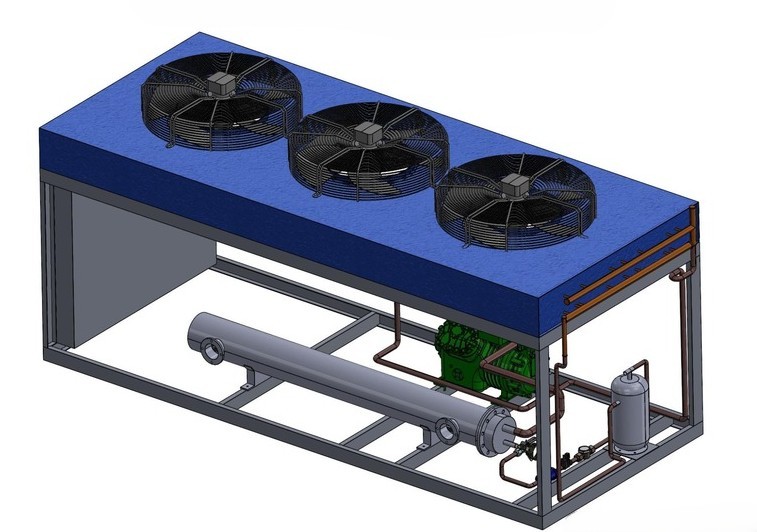Air cooled chiller fans are far more than mechanical blowers. They are the driving force behind heat rejection in the system. Without properly functioning fans, even the most advanced chiller system would fail to maintain the desired temperature. These fans pull ambient air across the condenser coils, helping to release heat absorbed from the cooling process. The quality, design, control, and efficiency of these fans play a decisive role in the overall effectiveness and energy consumption of the entire cooling system.
As industries, data centers, commercial buildings, and manufacturing units become more energy-conscious and operationally demanding, the role of high-performance, intelligent chiller fans is more important than ever. In this detailed guide, we’ll explore every aspect of air cooled chiller fans—from types and energy-saving technologies to real-world applications and innovations.
Types of Fans Used in Air Cooled Chillers
Different chiller applications and environments demand specific fan technologies. Here’s a look at the primary types:
Axial Fans
- Function: Move large volumes of air at low static pressure.
- Design: Blades rotate around a central axis; lightweight and energy-efficient.
- Usage: Widely used in standard HVAC systems and commercial chillers.
- Benefit: Cost-effective and ideal for environments with minimal airflow resistance.
Centrifugal Fans
- Function: Create high pressure; air is pulled in and expelled at a 90° angle.
- Design: Enclosed in a scroll housing; suitable for ducted applications.
- Usage: Used where space constraints exist or higher resistance (static pressure) is present.
- Benefit: Better performance in complex airflow configurations.
EC (Electronically Commutated) Fans
- Function: Variable-speed operation with integrated electronics.
- Design: Brushless motors with onboard controllers.
- Usage: Advanced chillers that prioritize energy efficiency.
- Benefit: Superior efficiency, low noise, and precise speed control.
Smart Fan Technology: Adaptive and Efficient
Modern chillers are equipped with smart fan technology that adapts in real-time to changing load conditions and ambient environments.
- Temperature Sensing: Fans adjust speed based on condenser or ambient temperature.
- Variable Speed Drives (VSD): Help control motor speed based on actual cooling demand.
- EC Motor Integration: Allows each fan to operate independently at optimal speeds.
Benefits:
- Reduced energy consumption during low load
- Less mechanical stress on the system
- Lower noise output
- Enhanced system life
Fan Redundancy Systems: Built for Reliability
For mission-critical operations like data centers, hospitals, and process industries, fan redundancy is essential.
How it works:
- Multiple fans are installed in parallel.
- If one fan fails, the remaining fans automatically increase speed to maintain airflow.
- Reduces pressure on compressors and prevents system shutdown.
Advantages:
- Enhanced reliability
- Minimal downtime
- Protection for costly equipment
Fan Noise: A Design Challenge
Fans are a primary source of noise in air-cooled chillers. Excessive noise can be problematic in residential zones, hospitals, and schools.
Noise Control Strategies:
- Blade Design Optimization: Airfoil or sickle-shaped blades reduce turbulence.
- Anti-Vibration Mounts: Isolate fans from the chiller frame to avoid noise transfer.
- Night Mode Operation: Reduces fan speed during off-peak hours to lower sound levels.
Result:
- Significant reduction in sound pressure levels (SPL), sometimes below 65 dB(A).
Energy Consumption: An Overlooked Cost Factor
Fan motors can consume 15–30% of a chiller’s total energy, especially in hot climates.
How to reduce this:
- Use IE3/IE4 motors (high-efficiency classification)
- Integrate EC fans for precise control
- Optimize fan pitch and angle for maximum airflow with minimum effort
Payoff:
- Lower electricity bills
- Reduced carbon footprint
- Shorter return on investment (ROI) for premium systems
Reverse Fan Operation: Self-Cleaning Functionality
In dusty environments like textile plants, cement industries, or desert regions, the condenser coils can clog quickly.
Solution:
- Reverse cycle fans temporarily spin in the opposite direction.
- Blow dust and debris off the coil surface.
- Often triggered automatically after certain intervals.
Benefits:
- Maintains optimal heat exchange
- Reduces manual maintenance frequency
- Protects coils from long-term degradation
Auto-Diagnostics & Predictive Maintenance
Advanced chillers now come with smart sensors that monitor the health of fans continuously.
Monitored Parameters:
- Fan motor temperature
- Vibration levels
- RPM fluctuation
- Electrical load
Alerts Triggered For:
- Bearing wear
- Motor failure risks
- Blade imbalance
Outcome:
- Scheduled maintenance rather than emergency repairs
- Extended fan and motor life
- Improved system reliability
With advancements in materials, motor technologies, noise suppression, and smart control systems, today’s air cooled chiller fans offer far more than just air movement. They bring precision, automation, and resilience to cooling systems, allowing businesses to meet increasing performance demands while lowering energy bills and maintenance efforts.
Whether you’re installing a new chiller or upgrading an old system, understanding the engineering and functionality of chiller fans can help you make smarter, more efficient choices. By choosing the right fan configuration and leveraging intelligent fan controls, industries can experience significant improvements in cooling efficiency, equipment life, and cost-effectiveness.

